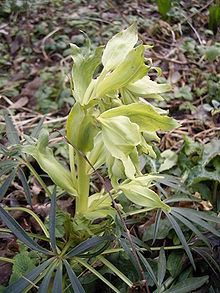Helleborus foetidus
| Helleborus foetidus | |
|---|---|

| |
| Scientific classification | |
| Kingdom: | Plantae |
| Clade: | Tracheophytes |
| Clade: | Angiosperms |
| Clade: | Eudicots |
| Order: | Ranunculales |
| Family: | Ranunculaceae |
| Genus: | Helleborus |
| Species: | H. foetidus
|
| Binomial name | |
| Helleborus foetidus | |
Helleborus foetidus, known variously as stinking hellebore
Description
It is an
All parts of the plant are poisonous, containing glycosides. Symptoms of intoxication include violent vomiting and delirium.[1]
Horticulture

H. foetidus is grown in gardens for its handsome evergreen foliage and large numbers of green, bell-shaped flowers borne in late winter. It prefers woodland conditions with deep, fertile, moist, humus rich, well-drained soil, and dappled shade. The species is, however, drought-tolerant. It often occurs naturally on chalk or limestone soils.
This plant has gained the Royal Horticultural Society's Award of Garden Merit.[4][5]
The cultivar 'Green Giant' has very bright green flowers and finely divided foliage; 'Miss Jekyll' has fragrant flowers, intensity varying with the time of day; 'Wester Flisk Group' has red-tinted leaves and stems and gray-green flowers; the 'Sierra Nevada Group' is
Propagation is by division or from seed, which can be prolific, naturalising well in ideal conditions. Rodents should be kept away from the garden since they depredate the seeds either when still in fruiting plants within the carpels or from the floor after seed release.[6]

References
- ^ OL 193794W.
- ^ Barley, Shanta (10 February 2010). "Stinky flower is kept warm by yeast partner". New Scientist. Retrieved 10 February 2010.
- PMID 20147331.
- ^ "Helleborus foetidus". RHS Plant Selector. Retrieved 6 August 2020.
- ^ "AGM Plants - Ornamental" (PDF). Royal Horticultural Society. July 2017. p. 47. Retrieved 3 March 2018.
- OCLC 808298507.
- "Helleborus foetidus L". Flora Europaea. Royal Botanical Garden Edinburgh. Retrieved 29 September 2014.
- Franklin Perring; Max Walters (1989). Macmillan field guide to British wildflowers. ISBN 978-0-333-44522-8.
- Flora, the gardener's bible. Ultimo, NSW, Australia: ABC books. 2006. OL 2373715W.
- Geoff Bryant; Tony Rodd; Kate Bryant (2005). Ultimate plant book. Collingwood, Victoria, Australia: CSIRO Publishing. OCLC 224966026.
